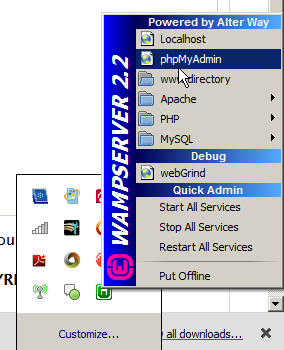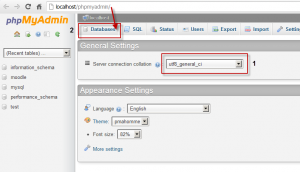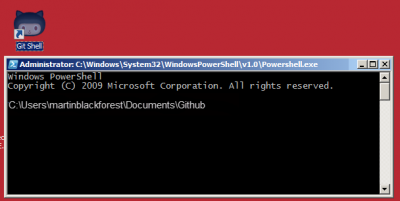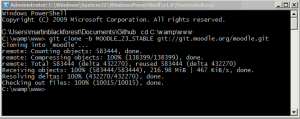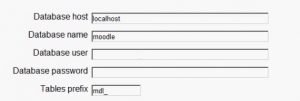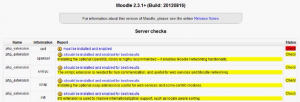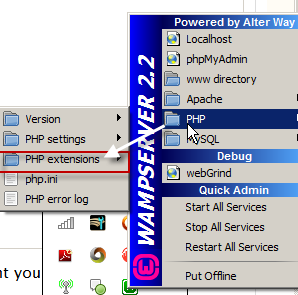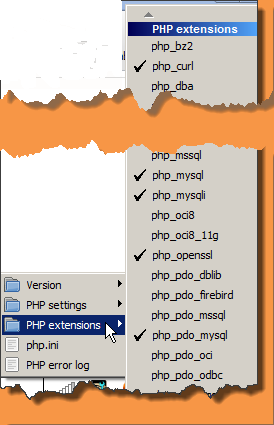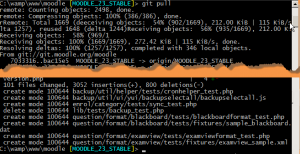Windows installation using Git
This page is for non-technical Windows users who would like to be able to keep a copy of LMS on their computers that they can easily and regularly update.
NOTE: These guidelines are intended for a Standard LMS installation on a Windows PC for a private or test LMS installation, NOT a production (public) site or service. If you wish to install LMS on a public site using Git then please see Git for Administrators. If you wish to contribute fixes or improvements using Git please see Development: Git for developers
If you prefer screencasts to reading, there is a youtube tutorial here
Contents
- 1 What you need to install LMS on your Windows pc
- 2 What is Git and why use it?
- 3 Getting the WAMP server
- 4 Making the database
- 5 Preparing to install LMS
- 6 Getting hold of Git
- 7 Getting hold of LMS
- 8 Installing LMS
- 9 Completing the installation
- 10 Updating your LMS
- 11 Troubleshooting and FAQ
- 12 See also
What you need to install LMS on your Windows pc
- somewhere on your pc to house it and keep it working,with a database to maintain its records. We will use WAMP server
- the LMS files themselves. We will use Github for Windows
What is Git and why use it?
Git allows LMSrs not only to quickly download the latest versions of LMS but also to
download and test out fixes by developers and to share with others their own changes which may potentially get integrated into LMS for the benefit of everyone. In this page we are merely going to use the system to download LMS onto our computer- (see the cycle in yellow in the screenshot)Git makes it easy for us to update LMS when new versions come out each week, and it gives you the potential when more familiar with it to grab other changes and help test it. However, if you merely want to have LMS on your Windows pc to practise and try things out and are NOT really interested in having all the latest changes then it might be easier for you to use the All in one Windows Installer package instead.
Getting the WAMP server
1. Go to Wampserver and click the Download button
2. You will probably need to click the button Wampserver (64 bits &PHP 5.3) 2.2E but to be sure, here is how to check if your pc is 64 bit or 32 bit)
3. You may get a warning You must install Visual C++ 2010 SP1 Redistributable Package x86 or x64 – download the appropriate package for you. This may take some time.
4. When it is done, come back to Wampserver and click the Download button again.
Download, save and run the program, making sure you keep a note of where it has installed it on your computer. It will be in a folder called wamp. as in the screenshot to the left.
Making the database
Once wampserver is installed you will see a W icon, either on your desktop, start menu or taskbar (according to what you selected when installing.) Click it to bring up its options and then click PhpMyadmin as in Screenshot A below.
Tip: You can also reach this screen by typing into your browser: http://localhost/phpmyadmin/
1.Make sure that Server connection collation says “utf8_general_ci” (1 in Screenshot B below)
2.Click “databases” – (2 in Screenshot B below)
3. Type a name for your database (how about “lms”?) Make sure you remember its name. Ensure Collation is set to utf8_general-ci. Click “Create”.

4.Click the “check privileges” to the right of your database name and then click “add user”.
5. Add your details as the database administrator. Choose “local” for the host Make sure you remember the name and password you set. Tick (check) all privileges and click “add user”.
Preparing to install LMS
Along with the folder containing all the LMS files, we need another folder to hold all the user data once LMS is up and running. This is traditionally called the “lmsdata” folder. We need to create a new folder for this before downloading LMS.
- Find your wampserver on your computer – for instance, in C:wamp.
- Note there is a folder called “www”. We will install LMS into there.
- If you wish, create a new folder called “lmsdata” in the wampserver folder, as in the screenshot – but if not, LMS will create it for you and suggest its name.
Getting hold of Git
- Go to Github for Windows and click the download button (currently in green, top right)
- You don’t need to make an account but if you do, it will help you later if you wish to use Git at a more advanced level.
- Let Windows do its work; save it and run it. It might take some time.
- Once it is installed, you will have two cat-like creature icons on your desktop, taskbar or start menu (depending on what you selected)
- Click the one called “Git shell”. It will bring up a black box:
Getting hold of LMS
The file path shown in your black box (“Windows power shell”) is where Git has made your personal repository. You can download LMS into there if you wish, but you will then have to copy the LMS folder into your wampserver directory. Instead, we will download LMS straight into the www folder of our wampserver directory.
1. Type
cd C:wampwww
(or whatever the path is to your wampserver directory and where you want to put LMS)
2. Type
git clone -b LMS_26_STABLE git://git.paradisolms.net/lms.git
(If you want a different version, see the #Troubleshooting and FAQ below.)
3. Wait! Lots of lines will appear and it might take a while. At the end you should see “Checking out files:100% done”
Installing LMS
- In your browser, type localhost/lms
- The LMS set up screen will appear.
- Much of this is straightforward form-filling. Pay attention to:
- the paths -does it know where to find your wampserver folder for LMS and lmsdata?
- the database details (which you should have remembered when setting up in section 4 above)
- the server check.
What are server checks?
LMS needs to ensure our wampserver has all the features (“extensions”) enabled to run it successfully.
Anything in green is fine. Anything in yellow is OK (but would be better in green). Anything in red will stop us installing LMS.
- Make a note of the ones in yellow or red (names are under the Information column)
- Click your W wampserver icon and click “php extensions” (screenshot 1 below)
- Tick those extensions you noted were yellow or red (screenshot 2 below)
Note: If you have problems enabling the curl extension, see the #Troubleshooting and FAQ below.
Completing the installation
- Once your server checks page shows all green or all green with some yellow, you can click “Continue”
- LMS will install – this will take some time. Be patient. When you see “workshop” you know you are nearly done.
- Complete details for your admin username and password (and remember them!)
- Complete details for your front page (name of your LMS, etc)
- Give yourself a pat on the back!
Updating your LMS
You can get a newer version of LMS every Thursday. To do this using Git:
- Click the Git shell avatar to open up the Windows powershell black box.
- If it shows a different directory from where you installed LMS, change the path by typing in
C:wampwwwlms
or wherever the path to your LMS folder is.
- You will see it now displays the name of the LMS version you installed (Screenshot 1 below)
- Type
git pull
- Lines will appear and your LMS will update itself automatically!(Screenshot 2 below)
- Note that
git pull
will also tell you if your version is currently up to date (Screenshot 3 below)
Troubleshooting and FAQ
I can’t get cURL extension to green (or even yellow) whatever I try.
It could be your downloaded wampserver had a corrupted cURL extension (mine did). Go to mediafire.com and download the cURL extenstion there. Unzip it and then add it into (for example) wamp>bin>php>php 5.3.13>ext. (The exact path will depend on where you saved your wampserver.) Let it override the original and try again.
I type localhost/lms but it doesn’t work!
Make sure your wampserver is working (“online”) The W icon should be green. If it isn’t, then click it and click “restart all services” or “start all services” and try again.
I want a different version of LMS
If you want an earlier version such as LMS 2.2 then type
git clone -b LMS_22_STABLE git://git.paradisolms.net/lms.git
If you want the latest, non-stable, development version of LMS (currently 2.4) then type
git clone git://git.paradisolms.net/lms.git
I want LMS in localhost and NOT localhost/lms
In the #Getting hold of LMS section, make sure your path does not include “www”. It might be for instance “C:wamp”. LMS will then download directly into your wampserver directory. Rename your “www” folder to “wwwOLD” and then rename your newly arrived lms folder to “www”.
See also
Using LMS forum thread Git for Dummies




